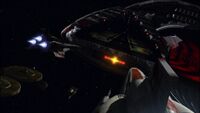Hands-on approach: Difference between revisions
No edit summary |
(edited to make the entry more "-pedia"-ish) |
||
| Line 1: | Line 1: | ||
[[Image:Viperapproach 104 1080i.jpg|thumb|200px|The ''ball'' shown in the -+- configuration ([[Final Cut]]).]] | [[Image:Viperapproach 104 1080i.jpg|thumb|200px|The ''ball'' shown in the -+- configuration ([[Final Cut]]).]] | ||
A '''hands-on approach''' refers to landing aboard a [[Battlestar (RDM)|battlestar]] under the pilot's full manual control, i.e. all flight control inputs come from the pilot, not from any automated system. This a very difficult skill, requiring much practice to master. | |||
There are two kinds of hands-on approaches: the [[Action Stations|condition three]]-mode landing, as performed by Lee Adama when first arriving on ''Galactica'' ([[Miniseries]]); and the high-speed [[Combat landing|combat landing]]. | |||
At the time of the surprise [[Cylon Attack]], complaceny allows battlestars to routinely use computerized auto-landing systems to network with a ship's controls and guide it into the flightpods. On ''[[Galactica]]'', [[William Adama]]'s orders make hands-on approach the only accepted landing procedure. The uniqueness of this policy is evident from [[Lee Adama]]'s confusion when he is instructed to land his [[Viper (RDM)|Viper]] Mk VII manually ([[Miniseries]]). | |||
Commander Adama has banned the use of auto-landing systems aboard ''Galactica'' because it would expose the computers to vulnerabilities exploited by the Cylons in the first war (such as [[Cylon computer virus|viruses]]), part of his no-networked-computers policy to protect against future Cylon attacks. | |||
[[Image:Handsonapproach.jpg|thumb|200px|Captain [[Lee Adama]] completes a hands-on approach in his [[Viper (RDM)|Viper]] Mk. VII ([[Miniseries]]).]] | |||
A typical [[wireless]] exchange for a hands-on approach between [[LSO|Landing Signal Officer]] and pilot might go like this: | A typical [[wireless]] exchange for a hands-on approach between [[LSO|Landing Signal Officer]] and pilot might go like this: | ||
Revision as of 06:25, 25 September 2007

A hands-on approach refers to landing aboard a battlestar under the pilot's full manual control, i.e. all flight control inputs come from the pilot, not from any automated system. This a very difficult skill, requiring much practice to master.
There are two kinds of hands-on approaches: the condition three-mode landing, as performed by Lee Adama when first arriving on Galactica (Miniseries); and the high-speed combat landing.
At the time of the surprise Cylon Attack, complaceny allows battlestars to routinely use computerized auto-landing systems to network with a ship's controls and guide it into the flightpods. On Galactica, William Adama's orders make hands-on approach the only accepted landing procedure. The uniqueness of this policy is evident from Lee Adama's confusion when he is instructed to land his Viper Mk VII manually (Miniseries).
Commander Adama has banned the use of auto-landing systems aboard Galactica because it would expose the computers to vulnerabilities exploited by the Cylons in the first war (such as viruses), part of his no-networked-computers policy to protect against future Cylon attacks.

A typical wireless exchange for a hands-on approach between Landing Signal Officer and pilot might go like this:
- LSO: "Viper seven niner one Galactica, you are cleared for approach ... Speed one seven five, port bay, hands-on approach, checker's green, call the ball [1]."
- Pilot: "Copy. I have the ball."
References
- ↑ The "ball" refers to the arrangement of crossed navigational lights at the lip of the landing bay, and/or the visual cue on a cockpit display (as seen in Kat's Viper in "Act of Contrition"). The pilot would use this to adjust his/her glideslope for a proper approach into the flight pod. The phrase "I have the ball" informs the LSO that the pilot has acquired this visual cue and is beginning the final approach.